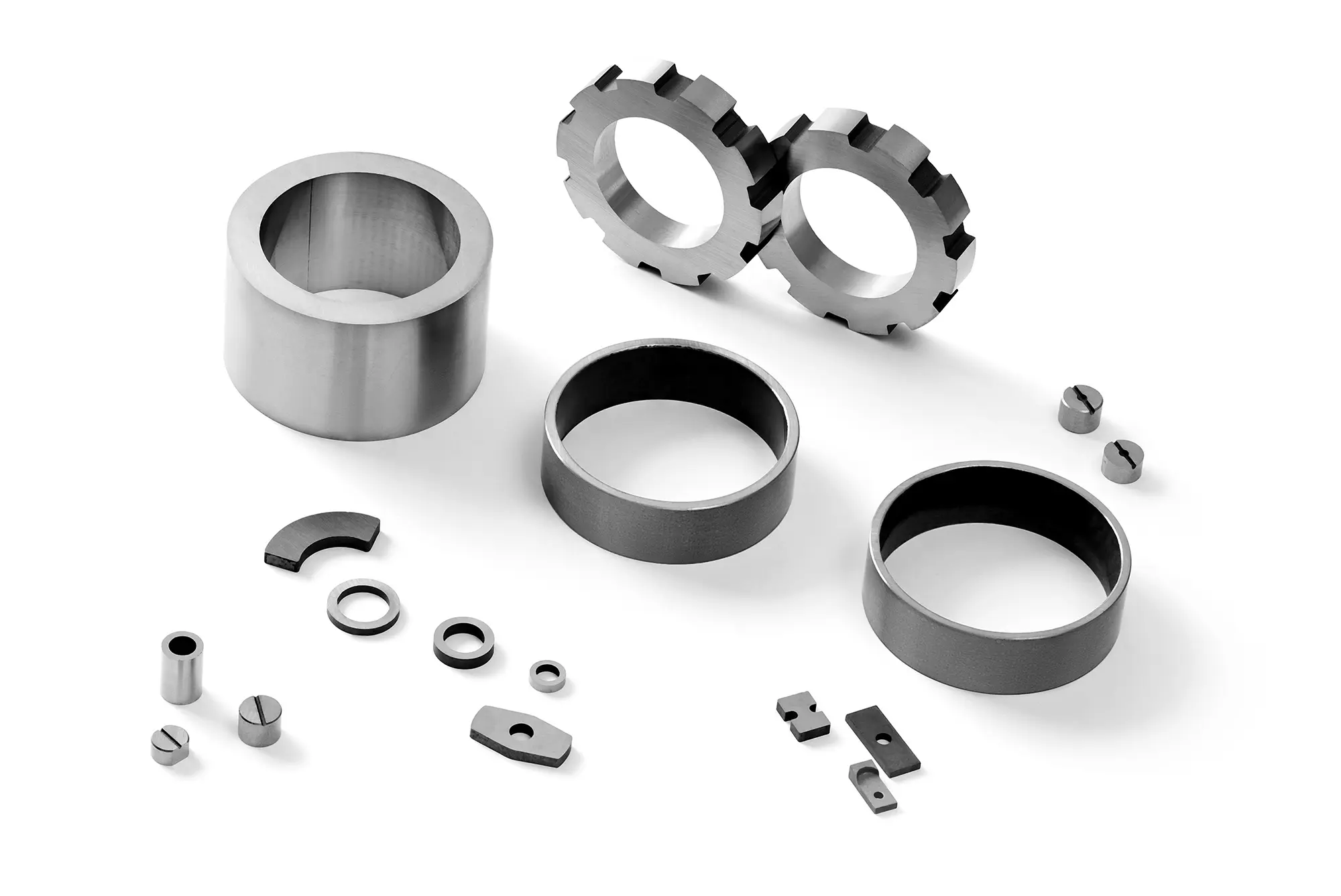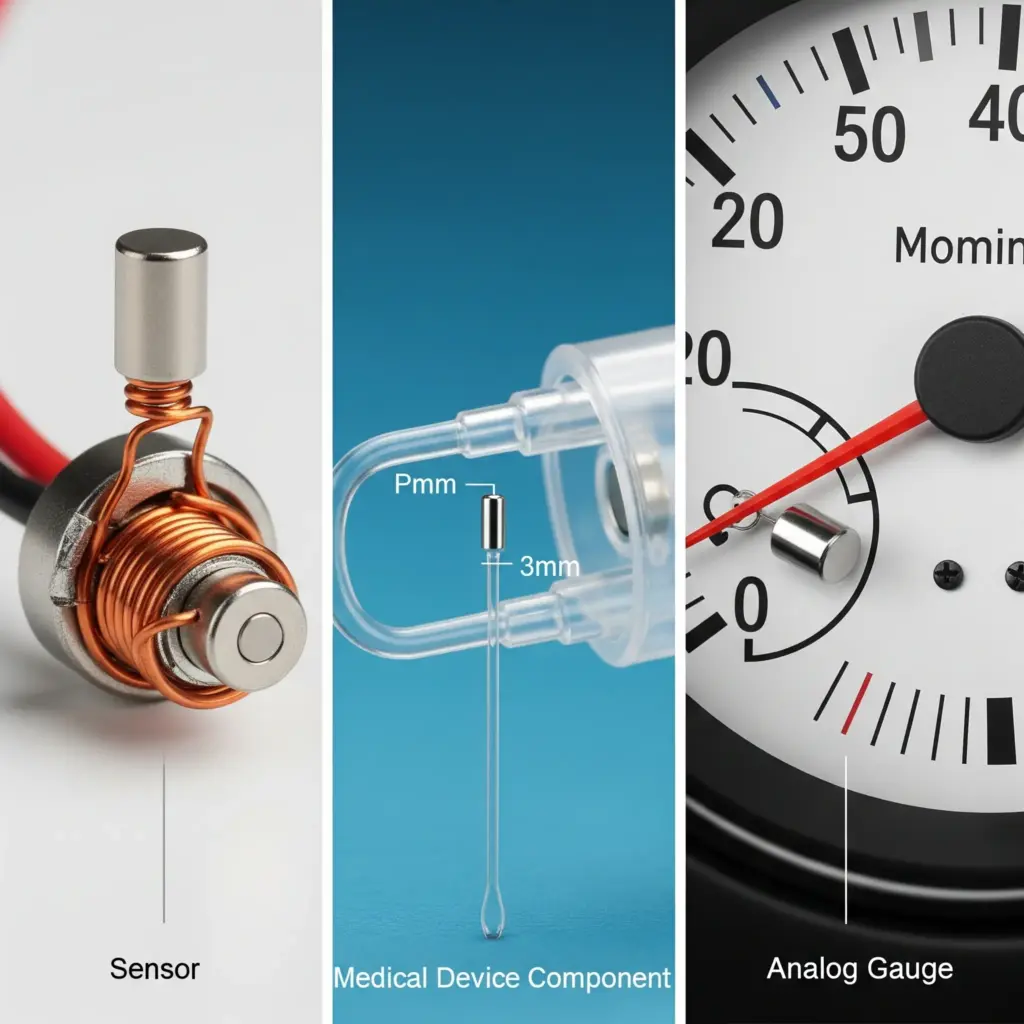Sintered Alnico Magnets in China
Sintered Alnico magnets represent a specific class of the Alnico family, distinguished by their manufacturing process. While sharing the same base elements of Aluminum, Nickel, and Cobalt, their powdered metallurgical production method gives them distinct advantages, particularly in terms of dimensional precision and mechanical strength. This makes them the preferred choice for applications requiring complex shapes and tight tolerances.
What is a Sintered Alnico Magnet?
Sintered Alnico magnets are created through a powder metallurgy process, which is an alternative to the traditional casting method. The process involves pressing fine Alnico alloy powder into a die, then heating it to a high temperature just below the melting point. This “sintering” process fuses the powder particles together, resulting in a solid, dense magnet.
The powdered metallurgy technique allows for the production of magnets with more complex geometries and smaller sizes than cast magnets, which are limited by the casting process.


Properties and Advantages of Sintered Alnico
Sintered Alnico magnets share many of the same magnetic properties as their cast counterparts, but with some key distinctions arising from the manufacturing process:
- Tighter Dimensional Tolerances: The sintering process allows for the creation of intricate shapes and smaller magnets with exceptional dimensional accuracy, which is difficult to achieve with casting.
- Higher Mechanical Strength: Sintered magnets are generally stronger and less brittle than cast magnets, making them more durable and less prone to chipping.
- Uniformity: The powder metallurgy process results in a more homogeneous magnetic structure, leading to more uniform magnetic properties throughout the magnet.
- High Temperature Stability: Like all Alnico magnets, the sintered variety performs exceptionally well at high temperatures, retaining its magnetic properties up to 550°C (1022°F).
- Good Corrosion Resistance: Sintered Alnico, like cast Alnico, has excellent resistance to corrosion and does not require a protective coating.
Step-by-Step Manufacturing Process of Sintered AlNiCo Magnets
1. Raw Material Preparation and Powder Production
The process begins with high-purity raw materials, similar to cast AlNiCo: iron (Fe), cobalt (Co), nickel (Ni), aluminum (Al), and additives like copper (Cu) or niobium (Nb). These are melted in a furnace to form an alloy ingot.
- The ingot is then atomized (sprayed with gas or water) or mechanically milled into fine powders (particle size: 1-10 microns). This creates a uniform powder blend.
- Powders are sieved and mixed to ensure even distribution, often with binders or lubricants to aid compaction.
Fun fact: Powder quality is critical—any contamination can weaken the final magnet’s properties.
2. Mixing and Compaction
The powders are thoroughly mixed in a blender to achieve a homogeneous alloy composition. For enhanced flow, a small amount of organic binder (like paraffin) may be added.
- The mixture is then compacted under high pressure (typically 500-1,000 MPa) using a hydraulic press or isostatic pressing machine. This forms a “green” compact—a fragile, shaped preform (e.g., discs, cylinders, or custom shapes).
- Compaction density is key: Aim for 60-70% of theoretical density to allow for sintering without cracking.
This step shapes the magnet without melting, making it ideal for complex geometries.
3. Sintering
The green compact is heated in a controlled-atmosphere furnace (often vacuum or hydrogen) to 1,200-1,300°C—below the alloy’s melting point (around 1,500°C). This causes the particles to bond through diffusion, densifying the material to 95-99% density.
- Sintering time: 1-4 hours, followed by slow cooling to prevent thermal stress.
- For anisotropic sintered AlNiCo (less common), a magnetic field is applied during sintering to align grains.
The result? A solid, porous-free magnet with refined microstructure.
4. Heat Treatment and Annealing
To optimize magnetic properties, the sintered piece undergoes heat treatment:
- Solution Annealing: Heated to 1,200°C and held to dissolve phases uniformly.
- Controlled Cooling and Aging: Quenched or slowly cooled, then aged at 500-600°C to form magnetic precipitates (e.g., Fe-Co phases).
- Magnetic field application during cooling enhances coercivity and remanence for directional magnetism.
This refines the crystal structure, boosting performance without altering the shape.
5. Machining and Finishing
Sintered AlNiCo is denser and harder than green compacts, so final shaping uses grinding, EDM (electrical discharge machining), or diamond tools:
- Excess material is removed to achieve precise tolerances (±0.01 mm for high-end apps).
- Surfaces are polished, and protective coatings (e.g., epoxy or nickel plating) are applied to resist corrosion.
This step ensures the magnet fits perfectly in devices like sensors or relays.
6. Magnetization and Quality Testing
The finished piece is magnetized using a strong electromagnet or capacitor discharge system to align domains permanently.
- Testing includes measuring magnetic flux (Br), coercivity (Hc), and energy product via tools like permeameters or hysteresis graphs.
- Non-destructive checks for cracks, density, and uniformity ensure compliance with standards like ASTM or ISO.
Approved magnets are then packaged, often with demagnetization protection.
Common Applications of Sintered Alnico Magnets
The precision and durability of sintered Alnico make it ideal for a variety of applications, especially those that are smaller in scale or require high accuracy:
- Sensors: Used in proximity sensors, position sensors, and anti-lock braking systems (ABS).
- Medical Devices: Components in medical instruments and equipment.
- Instrumentation: Found in analog meters, gyroscopes, and other precision measuring devices.
- Electronics: Used in switches, relays, and other small electronic components.

Get In Touch
Join hundreds of satisfied customers who trust HS Magnet for their critical magnetic applications.
Contact our expert team for technical consultations, custom solutions, or product inquiries

